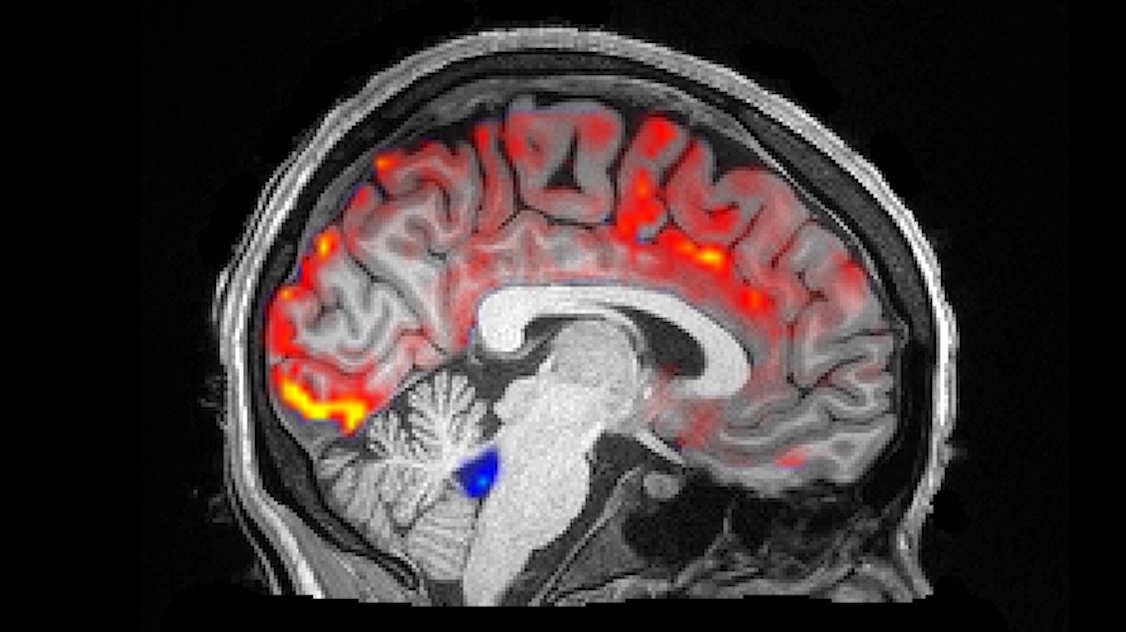How Deep Sleep May Help The Brain Clear Alzheimer’s Toxins

During deep sleep, waves of cerebrospinal fluid (blue) coincide with temporary decreases in blood flow (red). Less blood in the brain means more room for the fluid to carry away toxins, including those associated with Alzheimer’s disease.
Fultz et al. 2019
The brain waves generated during deep sleep appear to trigger a cleaning system in the brain that protects it against Alzheimer’s and other neurodegenerative diseases.
Electrical signals known as slow waves appear just before a pulse of fluid washes through the brain, presumably removing toxins associated with Alzheimer’s, researchers reported Thursday in the journal Science.
The finding could help explain a puzzling link between sleep and Alzheimer’s, says Laura Lewis, an author of the study and an assistant professor in the department of biomedical engineering at Boston University.
“Some disruption to the way sleep is working could potentially be contributing to the decline in brain health,” Lewis says.
The finding also suggests that people might be able to reduce their risk of Alzheimer’s by ensuring that they get high quality sleep, says William Jagust, a professor of public health and neuroscience at the University of California, Berkeley who was not involved in the study.
Scientists are already testing other lifestyle changes, like diet and exercise, to protect brain health. And sleep should be “high on the list” of measures worth trying, he says.
The study comes after decades of questions about the link between sleep and Alzheimer’s.
Studies show that people with Alzheimer’s often have sleep problems. And there’s growing evidence that people with sleep problems are more vulnerable to Alzheimer’s.
But there’s never been a good explanation for this connection.
“It’s been known for a long time that sleep is really important for brain health,” Lewis says, “but why it is was more mysterious.”
Lewis and a team of researchers wanted to solve the mystery.
So they found a way to use cutting-edge MRI techniques and other technologies to watch what was going on in the brains of 11 sleeping people.
One of the things they monitored was cerebrospinal fluid, or CSF, the liquid that flows through the brain and spinal cord.
“And that’s when we discovered that during sleep there are these really large, slow waves occurring maybe once every 20 seconds of CSF washing into the brain,” Lewis says.
These waves were a bit like the oscillations of a very slow washing machine.
Earlier studies of animals had found that the flow of CSF increases during sleep, and helps carry away waste products, including the toxins associated with Alzheimer’s.
But Lewis’s team was able to see this process occur in the brains of people — in real time. And that led to another discovery.
“Before each wave of fluid, we would actually see a wave of electrical activity in the neurons,” Lewis says. “This electrical wave always happens first and the CSF wave always seems to follow seconds later.”
The finding suggests that the electrical wave was triggering each wash cycle.
And the brain wave in question was a very familiar one called a “slow wave.” Slow waves appear when a person enters the state known as deep sleep, or non-rapid-eye-movement sleep.
And they play a role in both memory and brain disease, Lewis says
“It’s already known that people with Alzheimer’s disease have less of these electrophysiological slow waves, so they have smaller and fewer slow waves,” she says.
The new study suggests that this reduction in slow waves is reducing wash cycles in the brain, which would limit the brain’s ability to clear out the toxins associated with Alzheimer’s.
“It would make sense that if there’s large waves of fluid, of CSF, that that might in turn cause mixing and dispersion with other fluids in the brain and help with this waste removal process,” Lewis says.
Lewis’s team made one more discovery about sleeping brains. As the flow of cerebrospinal fluid increases, blood flow decreases.
Less blood in the brain means more room for CSF to carry away waste.
The study’s findings fit nicely with other research on sleep and Alzheimer’s disease, Jagust says.
He was part of a team that studied the relationship between slow-wave sleep and a toxin called beta-amyloid, which accumulates in the brains of people with Alzheimer’s.
They found something a bit disturbing.
“It’s a vicious cycle where amyloid decreases sleep and decreased sleep results in more amyloid,” Jagust says.
The new study results suggest the increase in amyloid could be the result of less waste removal in the brain, he says.
But Alzheimer’s, like heart disease, is likely to have more than one cause, Jagust says.
“There are a bunch of things that are probably contributing to people’s likelihood [of] getting Alzheimer’s,” he says, “and I think sleep is going to turn out to be one of them.”
9(MDAxODM0MDY4MDEyMTY4NDA3MzI3YjkzMw004))





